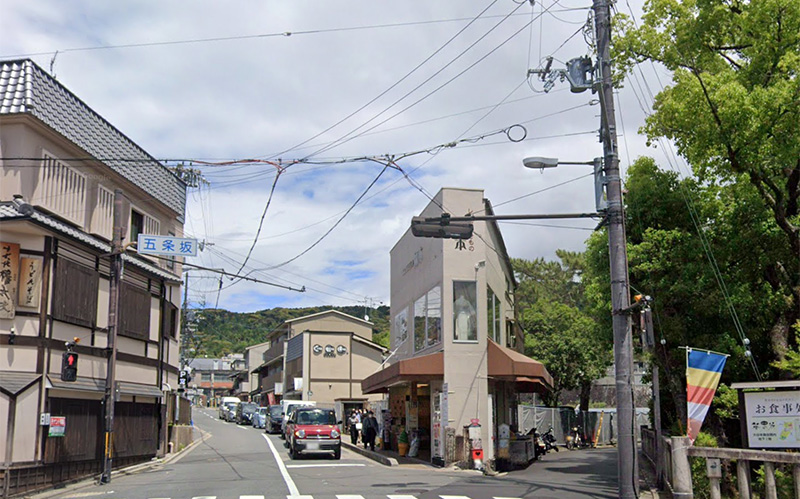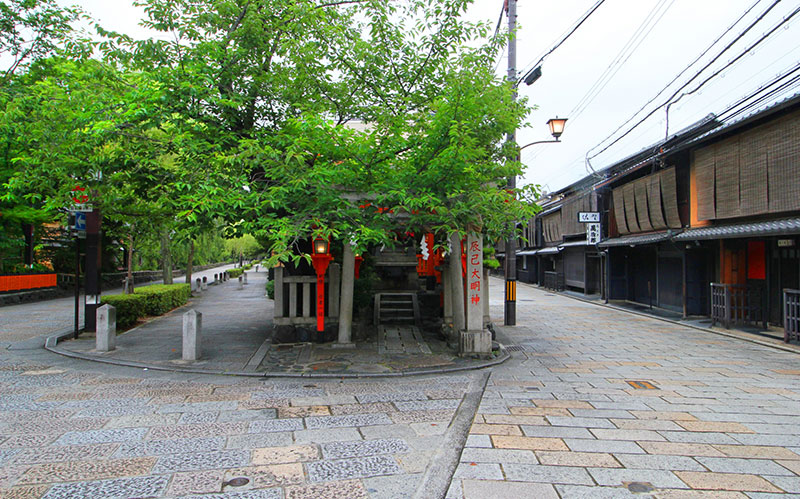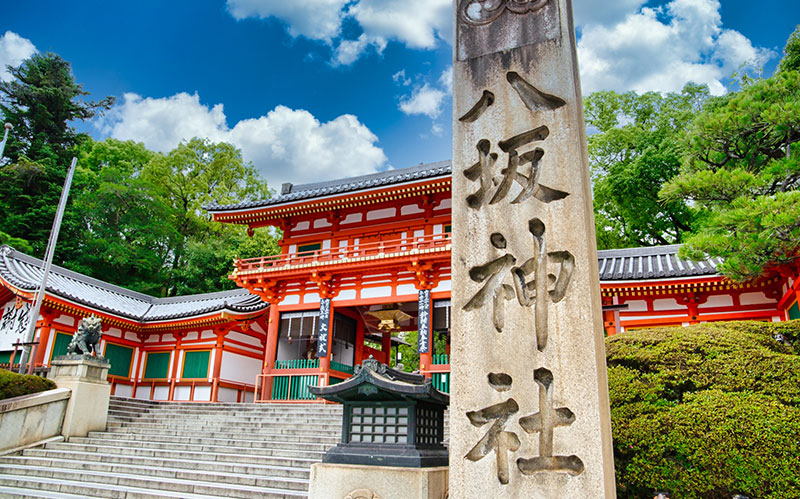Kyoto, with its rich seasonal landscapes, has long served as the backdrop for countless stories throughout history. For many readers, envisioning the Kyoto portrayed in stories set within its timeless scenery might evoke a sense of excitement and anticipation.
This time, we’ll embark on a stroll through Kyoto’s historic temples and shrines—places that have inspired and been featured in many of these stories.
Though Kyoto has become bustling with visitors from around the world, carrying a story in hand as you wander its sacred sites offers a chance to experience the city from a new perspective.
Now, let’s begin our journey.
- Today’s Route: Kyoto – A Walk Through the Sacred Sites of Stories
- Kyoto: Starting Our Walk Through the Sacred Sites of Stories
- A. (Start) Kyoto City Bus Gojozaka Bus Stop
- B. Kiyomizu‑dera Featured in Yasunari Kawabata’s The Old Capital
- C. Kōdai‑ji Featured in the Japanese Movie “What Did You Eat Yesterday?”
- D. Strolling through the Gion streets depicted in “Maiko-san Chi no Makanai-san” on the way to Yasaka Shrine
- E. Yasaka Shrine in The Tale of the Heike
- F. Kyoto City Bus – Gion Bus Stop
- Recap of the Stroll Through Literary Landmarks
- Kyoto Stroll : A Journey Through the Sacred Sites of Legends, from Kiyomizu-dera Temple to Yasaka Shrine Recommended articles in the vicinity
Today’s Route: Kyoto – A Walk Through the Sacred Sites of Stories
A. (Start) Kyoto City Bus Gojozaka Bus Stop
B. Kiyomizu-dera Temple
C. Kodai-ji Temple
D. Gion area
E. Yasaka Shrine
F. Kyoto City Bus Gojozaka Bus Stop
Kyoto: Starting Our Walk Through the Sacred Sites of Stories
A. (Start) Kyoto City Bus Gojozaka Bus Stop
Our stroll begins at the Gojozaka bus stop, located on Higashioji Street, a major thoroughfare and a central hub for Kyoto tourism. Nearby, you’ll find not only popular tourist destinations but also the historic Otani Sobyo, a revered cemetery known as “Higashi Otani,” which attracts many visitors.

A short walk south from the Gojozaka bus stop brings you to “Gojozaka,” a sharply angled road branching off to the left. This time, we’ll stroll along Gojozaka together with other sightseers.
Gojozaka is a bustling street, lively with both pedestrians and vehicles, so be sure to walk with care!
When it comes to Kyoto pottery, “Kiyomizu-yaki” is the first to come to mind. As its name suggests, Kiyomizu-yaki was traditionally crafted near Kiyomizu-dera. At the heart of this tradition lies Gojozaka.
Even today, Gojozaka is lined with shops specializing in pottery. Enjoy browsing the beautiful ceramics as you continue on your way.


Continuing along Gojozaka, you’ll eventually arrive at Kiyomizuzaka, a charming stone-paved street. Lined with numerous shops on both sides, Kiyomizuzaka is a delight to explore just by strolling through. Embracing the tourist vibe and enjoying some street food along the way adds to the fun!
If you keep walking straight, you’ll soon come to the impressive vermilion gate – the entrance to Kiyomizu‑dera, one of Kyoto’s most iconic sightseeing destinations.
B. Kiyomizu‑dera Featured in Yasunari Kawabata’s The Old Capital
Anyone with an appreciation for Japanese literature has likely read at least one of Yasunari Kawabata’s novels. You may even have found yourself captivated by his meticulous, beautifully rendered descriptions.
Yasunari Kawabata was also one of the literary figures who adored Kyoto. In his novel The Old Capital, he evokes a beautiful Kyoto of yesteryear—a city that slips ever farther into memory.
Kiyomizu‑dera, the first stop on our walk, is among the Kyoto settings featured in The Old Capital. It’s on this very stage that the protagonist, Chieko, confides her weighty secret.
Let’s explore Kiyomizu‑dera together alongside this internationally acclaimed masterpiece.

Kiyomizu‑dera is a beautiful temple perched atop a sloping path. Believed to have been founded in 778 AD, it stands as one of Kyoto’s oldest and most historic sanctuaries.
The temple’s principal image is the Eleven‑Faced, Thousand‑Armed Kannon—depicted with eleven faces and forty‑two arms. Renowned for her boundless compassion and power to aid those in need, she has long been beloved by devotees and continues to inspire deep faith.

As you approach Kiyomizu‑dera, the first thing you’ll notice is its grand, vermilion mountain gate. Officially called the Niōmon (Deva Gate), its vivid red hue has earned it the nickname “Red Gate.” Flanking the gate are the Niō guardian statues—among the largest in Kyoto—whose fierce, penetrating gazes seem to see straight through you.
The temple grounds themselves are relatively expansive and crisscrossed with sloping paths. Take your time as you explore, pausing to rest whenever you like.


When it comes to Kiyomizu‑dera, its renowned “Kiyomizu Stage” —the broad balcony of the main hall —offers sweeping views of the city. Step out onto the stage, take in the panorama of Kyoto, and let yourself feel like the protagonist of a story.
Be sure, too, to explore the Oku‑no‑in deeper in the complex, which boasts its own stage modeled on the main hall’s.
Additionally, Kiyomizu‑dera has plenty of other highlights, such as Jishu Shrine—famed for its matchmaking blessings—and the Otowa Waterfall. If you’re hoping to foster a good connection, I recommend visiting these spots together as you explore the temple.
Once you’ve enjoyed all that Kiyomizu‑dera has to offer, let’s move on to our next stop.
Head back to the Niōmon (the vermilion gate) and continue straight along Kiyomizuzaka. After a short walk, you’ll spot a narrow, stone‑paved lane branching off to the right. Flanked by traditional Kyoto houses on both sides, this charming street is known as Sannenzaka.

Sannenzaka is lined with quintessential Kyoto shops, and it’s a pleasure to simply stroll by and take in their offerings. With numerous eateries—such as soba noodle shops—along the way, you’ll have no trouble finding a snack if hunger strikes.
After walking a short way, you’ll see the narrow lane of Ninenzaka on your right. Turn onto Ninenzaka and follow it until you reach a street marked by a large torii gate on the right. At the end of that street, you’ll find stone steps leading up—this is the entrance to our next destination, Kōdai‑ji.
Kiyomizu-dera Temple
Address:1-294, Kiyomizu, Higashiyama-ku, Kyoto-shi, Kyoto, 605-0862, Japan
Visit the official website here
C. Kōdai‑ji Featured in the Japanese Movie “What Did You Eat Yesterday?”

Are you familiar with the Japanese manga “What Did You Eat Yesterday? ” by Fumi Yoshinaga?
It’s a popular work in Japan—though its subject may put some off, it’s a heartwarming story of a same‑sex couple that weaves together mouthwatering dishes and the ups and downs of everyday life.
The TV drama adaptation is equally wonderful, full of respect for the original, and in the theatrical film version you’ll even see Kōdai‑ji on screen.
In the film, Shiro takes Kenji’s hand as they stroll through a bamboo grove. As we explore Kōdai‑ji, let’s keep their feelings in mind.

Kōdai‑ji was built in 1606 by Nene, the principal wife of Toyotomi Hideyoshi, to honor his memory. The temple is renowned for its cherry blossoms and autumn foliage, and—together with the bamboo grove mentioned earlier—is illuminated from spring through autumn.
After paying the admission fee at the reception desk, follow the signs as you begin your visit. On the temple grounds, you’ll find the Kaizando Hall—an Important Cultural Property that has remained unchanged since its founding. Seeing it so perfectly in harmony with the surrounding landscape somehow brings Nene and Hideyoshi’s characters to life.

Afterward, as you leave Kōdai‑ji, take in the views of the beautiful gardens and the bamboo grove. To conclude your visit, I recommend a rest at Ungoan, where you can savor a bowl of matcha tea and some traditional Japanese sweets.
Exit Kōdai‑ji on its west side onto Nene‑no‑Michi. After a short walk south along Nene‑no‑Michi, you’ll spot a very narrow lane on your right. This charming alley, called Ishibei‑koji, overflows with the quintessential atmosphere of Kyoto. While there are several routes to our next destination, today we’ll follow this delightful path.

Continue along Ishibei‑koji, where stately wooden buildings line the path and evoke a modern elegance. Scattered here and there are exquisite ryōtei (traditional Japanese restaurants), each offering a tangible sense of Kyoto’s history.
After a short walk, you’ll arrive at Shimogawara‑dōri, a somewhat wider stone‑paved street. Turn right onto Shimogawara‑dōri and continue to the first intersection, then turn left. Ahead of you will be the main thoroughfare, Higashioji‑dōri.
Cross Higashioji‑dōri and continue straight ahead. As you follow the road, you’ll come to Hanami‑kōji‑dōri.
Jubuzan Kodai-ji Temple
Address:526 Shimokawara-cho, Higashiyama-ku, Kyoto-shi, Kyoto-fu
Visit the official website here (Japanese text only)
D. Strolling through the Gion streets depicted in “Maiko-san Chi no Makanai-san” on the way to Yasaka Shrine
This may be somewhat different from our previous focus, but this time let’s take a stroll through one of Kyoto’s districts rather than a specific site. That district is Gion. Renowned worldwide as a hanamachi (entertainment quarter), Gion attracts visitors from both Japan and abroad.

When it comes to the stars of Gion, they are the maiko—apprentice geisha—who wear their distinctive yet exquisite makeup and don sumptuous kimono. In the manga Maiko-san Chi no Makanai-san, you can witness the meticulously depicted daily life of these maiko—from the mouthwatering dishes prepared by the young protagonist, Kiyo, to the maiko way of life led by Kiyo’s friend Sumire (Hyakuhana). Let’s stroll through the streets of Gion while imagining these scenes.

Head north along Hanamikoji. After a short walk, you’ll find the Gion Kobu Kaburenjo Theatre on your right. This theatre is where maiko and geiko perform, and it’s also the venue for the Miyako Odori, which is featured in the manga Maiko-san Chi no Makanai-san.

Additionally, at the Gion Corner adjacent to the Gion Kobu Kaburenjo Theatre, you can enjoy digest performances of various traditional arts. While a ticket fee applies, it’s well worth the experience.
Ryōtei line both sides of Hanamikoji. Though it can be difficult to step inside, simply gazing at them lets you savor Kyoto’s unique charm. Among these establishments, you might even spot one that Hyakuhana visited.
Let’s stroll along Hanamikoji at a leisurely pace. After passing through the beautiful stone-paved street, you will emerge onto the main thoroughfare, Shijo-dori. Turn right onto Shijo-dori and head toward our final destination.

Shijo-dori is a lively commercial street lined with a variety of shops. As you admire the traditional stores alongside the new, fashionable boutiques, make your way toward the red gate visible at the end of Shijo-dori.
There, at the terminus of Shijo-dori, you’ll find our final destination: Yasaka Shrine.
GIONKOUBU
Address:570-2, Gion-cho, Higashiyama-ku, Kyoto, 605-0074, Japan
Visit the official website here
E. Yasaka Shrine in The Tale of the Heike

Yasaka Shrine, located in Gion-Shijo in Kyoto, is a historic shrine founded in 656 AD, and its vermilion torii gate and main stage hall grace the beautiful precincts. On the grounds still stands the “Tadamori Lantern,” donated by Taira no Tadamori, a spot that evokes the shrine’s connection to The Tale of the Heike.

The shrine’s principal deity is Susanoo-no-Mikoto, believed to ward off misfortune and bring business prosperity. The grounds, adorned in vibrant vermilion, are open for visitors to explore at their leisure—so take your time as you pay your respects.

The highlight of Yasaka Shrine is undoubtedly its ever-changing seasonal beauty. In spring, cherry blossoms burst into bloom; in summer, the fresh greenery is a refreshing sight. In autumn, the brilliant red foliage stands out vividly; and in winter—though rare—the snow-covered vermilion tower gate presents a scene of otherworldly beauty.

Additionally, in July the major Gion Festival takes place. Spanning an entire month, this festival at Yasaka Shrine is said to have originated as a ritual to ward off epidemics. Since the crowds swell significantly during this period, please exercise caution when attending the Gion Festival.
When you pay your respects, be sure to take note of the honden (main sanctuary) as well. Yasaka Shrine is built in the Gion-zukuri architectural style, in which the main sanctuary and worship hall are covered by a single roof. This rare style exists nowhere else but at Yasaka Shrine.
After enjoying the scenery of Yasaka Shrine and paying your respects at its various subsidiary shrines, our stroll comes to an end. Exit Yasaka Shrine and head for the final bus stop.
Yasaka Shrine
Address:625 Gion-cho north sides, higashiyama Ward, Kyoto City
Visit the official website here
F. Kyoto City Bus – Gion Bus Stop
Exit Yasaka Shrine, cross Higashioji-dori, and turn right. After a short walk, you’ll see “Yoshimoto Gion Kagetsu” on your left. This theater, operated by Yoshimoto, hosts a variety of events and comedy performances. The Kyoto-original “Gion Yoshimoto Shinkigeki” is also highly recommended.
The final stop of our walk—the Gion bus stop—is located right in front of Yoshimoto Gion Kagetsu.
On this stroll, we immersed ourselves in worlds of story and history. Take a moment here to bring your mind back to the present time and place before heading home.
When you get home, I hope that as you recall the scenes from your walk, you’ll feel even a spark of interest in what we introduced today.

Recap of the Stroll Through Literary Landmarks
※This walk includes some sites that require an admission fee.
A.((Start) Kyoto City Bus Gojozaka Bus Stop
↓ 750m
B. Kiyomizu-dera Temple
↓ 650m
C. Kodai-ji Temple
↓ 900m(To Hanami-koji Street)
D. Gion area
↓ 220m (At Shijo Street)
E. Yasaka Shrine
↓ 250m
F.(Goal)Kyoto City Bus Gojozaka Bus Stop
